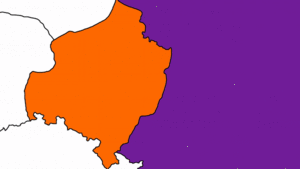(Created page with "{{PCBAWar | title = 2nd Polish-Sorbian War | image = File:PCBW PSNR ZZBLOCKINGHIGHWAY.png | caption = The ZZ blocking the 25 Highway passing through Konin | date = 12 October 2039 - 1 November 2039 | location = Greater Poland | result = Polish victory<br> *File:PSNRball.png PSNR Annexation of Greater Poland<br> *File:PSNRball.png PSNR withdraws from occupied lower Silesia | combatants1 = File:PSNRball.png Polish Social Nationalist Republic * File:TheNightma...") |
No edit summary |
||
| Line 47: | Line 47: | ||
The conflict escalated further on October 12 when an incident involving a woman fleeing an unknown court proceeding led to a clash between ZZ and SOPOW on the Polish-Sorbian border. Subsequently, ZZ entered Greater Poland and occupied Konin. On October 13, the Polish government endorsed ZZ's actions and joined the conflict by entering Greater Poland alongside them, marking the commencement of hostilities. | The conflict escalated further on October 12 when an incident involving a woman fleeing an unknown court proceeding led to a clash between ZZ and SOPOW on the Polish-Sorbian border. Subsequently, ZZ entered Greater Poland and occupied Konin. On October 13, the Polish government endorsed ZZ's actions and joined the conflict by entering Greater Poland alongside them, marking the commencement of hostilities. | ||
[[File:SecondPolish-Sorbianwar-ezgif.gif|thumb|Course of the 2nd Polish-Sorbian war]] | |||
Revision as of 07:54, 5 February 2024
The Second Polish-Sorbian War, also known as the Poznań War, unfolded as a confrontation between the Polish Social Nationalist Republic (PSNR) and the Republic of Sorbia. The roots of this conflict lay in the persistent diplomatic failures of the PSNR to resolve the territorial dispute over Greater Poland. On May 29, 2039, the PSNR attempted to garner international support by publicly advocating for an Alternative United Nations (AltUN) resolution to address the matter. The Kultokrat of the PSNR, Hubert Ziółkowski, sought to prevent the contested territory from becoming a future source of conflicts and endeavored to leverage the positive Polish-Sorbian relations for diplomatic negotiations.
Regrettably, the AltUN vote on the proposed resolution proved unsuccessful. Subsequently, Kultokrat Ziółkowski resorted to indirectly confronting Sorbia's leader, Tamaraw Vlasov, through televised speeches. However, this tactic backfired as Vlasov and leaders from various nations expressed their opposition to altering the status quo in the Greater Poland region. Eventually, in June 2039, an agreement was brokered between Kultokrat Ziółkowski and Vlasov. This accord stipulated that Sorbia would conduct a survey in Greater Poland to assess the population's preferences, potentially leading to a redrawn border based on those preferences. The agreement set the deadline for October 1, 2039.
Upon Sorbia's failure to meet the deadline, the Polish Sejm, on October 3, 2039, passed anti-Sorbian legislation. This encompassed a comprehensive embargo on vital agricultural products such as wheat, potatoes, and other agricultural goods originating from Sorbia. Additionally, the sale of military equipment to Sorbia was suspended. Responding to this, on October 6, the Central European Commerce Authority (CECA) unanimously imposed sanctions on Sorbia. These sanctions had the effect of freezing Sorbian assets across numerous European countries and halting all transactions and funding to and from Sorbia.
The conflict escalated further on October 12 when an incident involving a woman fleeing an unknown court proceeding led to a clash between ZZ and SOPOW on the Polish-Sorbian border. Subsequently, ZZ entered Greater Poland and occupied Konin. On October 13, the Polish government endorsed ZZ's actions and joined the conflict by entering Greater Poland alongside them, marking the commencement of hostilities.
